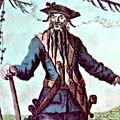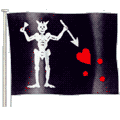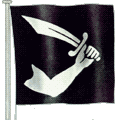Famous Pirates and Privateers T
|
|
 |
John Taylor
Active Early 1700's |
Taylor was with Edward England when England captured a 30 gun sloop off Africa
in 1719. Taylor was given command of the ship which he named the Victory. Together they captured
the ship Cassandra. Because England had shown mercy toward the captain of the captured
sloop, he was deposed and put ashore and Taylor took charge of England's crew. Taylor
hunted in the Indian Ocean where he took several small European and Indian ships. He also chased
away a British naval squadron which he originally believed to be the fleet of pirate Conajee Angria.
Taylor next went to the Dutch port of Cochin to reprovision his ships, but was forced to pay
heavy bribes once in port. Taylor careened his ships at Mauritius and Saint Mary's Island.
There he was joined by Olivier La Bouche who assumed command of the Victory. La Bouche
headed for Reunion Island in 1721 where they captured the Portuguese carrack Nostra Senhora de Cabo,
and took its diamond and rare oriental treasures.
La Bouche headed for Madagascar before divvying up the booty. Once there, the crew divvied up their
loot then burned the Victory replacing it with the Nostra Senhora de Cabo, which they renamed the Victory.
Taylor and La Bouche parted company 1722. Taylor took the Cassandra and headed for Panama, arriving there in
1723. In Panama, the governor of Portobello pardoned Taylor and his crew in exchange for his ship.
It is believed that Taylor may have gone on to become a captain in the Panamanian coast guard. |
Edward Teach or Thatch
AKA Blackbeard
British Pirate
1716 - 1718
 |
Teach had a thick, black beard which
was braided and tied with ribbons. To look intimidating, he went
into battle with three pairs of pistols strapped across his chest, daggers and pistols
in his belt, a cutlass, and a slow-burning thick hemp cord tucked under his hat which
produced lots of smoke.
He served under Captain Benjamin Hornigold, then later captured a French merchant ship which he renamed
the Queen Anne's Revenge.
Blackbeard's pirate career was short-lived. In 1718, the Governor of Virginia commissioned
Lieutenant Robert Maynard to bring him back dead or alive. Maynard tracked Blackbeard down
and found him in the Ocracoke Inlet in North Carolina.
After a bloody battle, Blackbeard collapsed in a pool of blood and his pirate crew surrendered.
Maynard had Blackbeard's head cut off, and returned for his reward with it hanging from the bowsprit
of his ship. Blackbeard's crew were tried in Virginia and all but one was found guilty and hanged.

|
Guillaume Le Testu
French Pirate
Active 1551 - 1572 |
Captain Le Testu was born at Le Havre in Normandy. His exact date of birth is unknown, but is believed to
be circa 1509. At Dieppe he studied navigation and was pilot of a French ship during an exploration
mission of Brazil in 1551.
Le Testu participated in an expedition which founded a colony near Rio de Janeiro in 1555
and in 1556 he was appointed royal pilot and presented to King Henry II a world atlas which
consisted of 56 maps, which he drew.
Le Testu's atlas included a southern continent which didn't exist, stating, "Not imaginary
even though no one has found it."
During the 1500's France was in turmoil over religion. France had been catholic for centuries and
in the 1520's Lutheranism entered the country. By 1534 Lutheranism threatened Catholicism and the crown
adopted a policy of rooting it out, by force if necessary. Calvin (also a Frenchman), an outspoken man
of Protestant ideas whose ideas were expressed as Calvinism and by 1540 he had gained quite a bit of
support for his cause. In the 1550's many of the Noblemen, being on the side of the Protestants fought
against the local churches and established the church. By this time France had effectively been
split into two religious parties, the Catholics and the Calvinist (who were, by this time called the
Huguenots). The tensions between the parties escalated until fighting broke out in the spring of 1562.
The war was temporarily ended in 1563 when the Edict of Amboise was issued. It gave limited right of
worship to the Huguenots. This was a diversion set up by the crown while they tried to gain support
from the people. This was only temporary for the Catholics were about to enlist the aid of Spain in
their cause. In 1567 warfare broke out again due to the fear of an alliance with Spain. It was during
this time that Le Testu raided for the Huguenot side. He raided throughout 1567 and 1568 until he was
captured by the Catholics. He was imprisoned for the next four years when King Charles IX, after being
subjected to many pleas, allowed his release. The religious wars would continue long after Le Testu's
death.
Le Testu became captain of an 80 ton warship with about 70 men in his crew. Sir Francis Drake
encountered Le Testu in April 1573 off Panama. Just why Le Testu was cruising around Panama is anyone's
guess. Spanish reports of the time stated that the French were planning a large expedition for 1572 but
it is more likely that he was cruising on his own. Whatever his reason, Le Testu joined Drake in an
attack on a mule train carrying treasure to Nombre de Dios. The attack was a complete success and the
pirates loaded themselves with as much gold as they could carry, burying the rest. Le Testu's booty
was around £20,000.
Le Testu was wounded in the assault and choose to remain behind to regain his strength.
Two of his men stayed with him. While resting, Spanish soldiers fell upon them and Le Testu
was killed. Le Testu was beheaded and his head was put on prominent display in the marketplace
at Nombre de Dios. |
Thomas Tew
American Privateer
Died 1695
 |
Thomas Tew was a famous pirate headquartered in Madagascar.
Under commission, Tew sailed in consort with Captain Dew from Barbados to join with the Royal African
Company in an attack on the French factory at Goori, Gambia.
But instead of going to West Africa, Tew and his crew turned pirate and sailed to the Red Sea.
There he encountered a richly-provisioned Indian ship and promptly attacked.
Prevailing in the battle, he took her as a prize. The booty made each of Tew's crew members rich.
Laden with this new-found wealth, they sailed to Madagascar.
Tew was soon held in high esteem by the pirates who resided in that favorite stronghold.
According to Johnson's "A General History of Pirates," it was at this time that
Tew met the legendary French pirate Misson, in his garden city of Libertalia.
A quarrel arose between Misson's French followers and Tew's English pirates and a
duel was arranged between the two leaders, but with the help of one of the pirates who was a
former Italian priest, they were able to settle their differences amicably.
Tew was appointed Admiral and the diplomatic ex-priest suitably chosen as Secretary of State
to the little republic. Tew had such a reputation for kindness that ships seldom resisted him;
upon learning who their assailant was they gave themselves up freely. Around this time some of
Tew's men sailed off to start a colony on their own. The Admiral followed trying to persuade
them to return to the fold at Libertalia. The men refused, and while Tew was arguing with them,
his ship was lost in a sudden and fierce storm. Tew was soon rescued by the ship Bijoux with
Misson on board, who, with a few men had narrowly escaped being massacred by the natives.
Tew must have realized that the eastern waters were becoming less hospitable to pirates.
Furnished with an equal share of gold and diamonds from Misson's last venture,
he made his way to back to America and settled down in Rhode Island.
Tew was now a wealthy man. With an honesty rarely encountered in those who pursued his trade,
he kept a promise to his friends in Bermuda, who had originally set him up with a ship,
and sent them fourteen times the original cost of the sloop as their share of the profits.
In the end Tew, found the call of the sea and the lure of the grand account irresistible.
He consented to take command of a pirate ship en route to the Red Sea. Soon after his arrival,
Tew attacked a large ship belonging to the Great Mogul and during the battle was mortally wounded. |
 |
|


